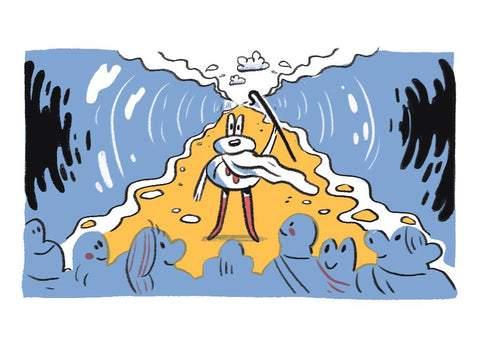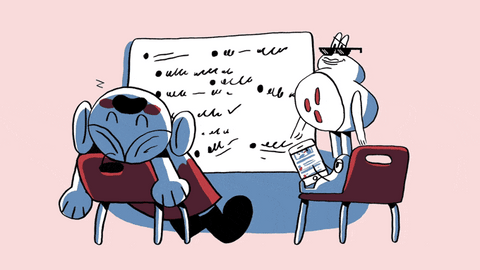Pitches can be daunting. So much is out of your control – like the competition. But you can control how you present yourself and what you offer.
Your audience can only be impressed if you capture their attention and keep them engaged. Stories have been used for this since the dawn of human communication. Use storytelling in your pitch to stand out, make a great impression and stick in your audience’s memory – long after the competition.
How to use storytelling in your pitch
Here are 10 straightforward ways to add storytelling to your pitch, inspired by Storyteller Tactics. You don’t need to use them all – just choose the ones that work for you.
1. Prime your creativity
If you have just spent hours crunching numbers or designing slides, you might not be at your most creative. Take a break! Then try writing some silly stories of your own on an unrelated topic.
For example, choose a random object in your house. Something mundane like a mug. Imagine: you love that mug. It’s your most prized possession. What story could you write to explain how that came to be?
Example:
That mug – the plain white mug? It's one of my most treasured possessions. You see, when I was at college we would make up silly games and I always lost. Every week for *six* months. But one day, when we were all playing a game of makeshift 'golf', I hit a hole-in-one into that mug from 100m! That single win, in that specific mug, finally broke my losing streak and turned my shame to pride. We still talk about that heroic shot when we meet up to this day."
Now you’re thinking creatively, dive into your pitch story.
2. Embrace the power of emotions in your pitch story
Stories resonate when they connect emotionally. Work through the story of what you are pitching from start to finish and note down the key emotions present at each stage. Think about the frustrations or excitement that led you to develop your product or service. Did you solve a problem that once left you stuck? Share that emotional journey.
Alternatively, tell a story about your customer. Start with their struggle, highlight the relief they’ll feel when they use your product, and end on a shared high note – the joy at the success you’ll create together. Use words that clearly express these emotions.
No gripping story is good news straight from the get-go – that isn’t interesting. For someone to need whatever it is you’re pitching, there must be a gap or deficiency somewhere. Something that isn’t as good as it could be. Negatives create opportunity, so don’t gloss over them.
Example: A mattress company coined the phrase 'junk sleep' to describe poor sleep (such as that you would get on a competitors mattress). By giving a name to the struggle they help their customers overcome, they created fuel for an ongoing and memorable ad campaign.
3. Add a story arc to your pitch story
A great story has a beginning, middle and end – a rise and fall that keeps people interested. Here we’ll explore the ‘man in a hole’ story arc. Author Kurt Vonnegut once said “Nobody ever lost money telling the story of a man in a hole”, and there’s something to that. Identify the following moments in your story:
-
Comfort zone: Where it all started – things were fine, but not great.
-
Trigger: Something happened, sparking the journey.
-
Crisis: Problems arose, but this led to discovery.
-
Recovery: You made changes, things improved.
-
Better place: The happy ending – where you’ll be after your pitch succeeds.
Use this arc to structure your entire pitch, or include it as a standalone story.
4. Show the big picture and the small picture in your pitch story
The big picture is the grand result: the money, the awards, the seismic change. But the small picture – the story of one person – is what people remember.
For instance, tell how your product made a difference in one customer’s life. Name them, share their emotions, and come back to their story throughout your pitch to keep it relatable and real.
5. Stick to three key points
Don’t overwhelm your audience. Choose three key takeaways you want them to remember. Imagine they’re describing your pitch to others – which three words or phrases do you want them to use? Structure your pitch around these points, and return to them at the end.
For example, the British sustainability campaign could have used the five Rs (reduce, reuse, repair, rot, recycle), but who would have remembered all those? Instead, they chose three for a memorable title: reduce, reuse, recycle.
6. Choose images that reinforce your story
Choosing images for slides can be tricky. But it’s important to minimise the amount of text you show. Your audience can read in their head much faster than you can read out loud. So don’t take the focus away from you with paragraphs of text. Choose an image instead. Here’s what makes for a good image:
-
Something that represents that small story you identified in tip 4. Perhaps the person, or a stock image representing that person.
-
Something simple, attractive and symbolic. If you’re talking about a new start or growing something, you might choose an image of a seedling.
Avoid cluttered slides or pictures that might distract from you. When you show a new image, immediately talk about the point that makes it relevant. This allows people to process the meaning of the image, before returning their attention to you.
7. Add mystery or secrets to your pitch story
People are naturally curious. Harness that curiosity to maintain engagement with your pitch by adding a secret to your story.
How?
Try adding one of the following words to your title or intro: secret, confidential, insider, exclusive, hidden, restricted, banned, untold, forgotten.
Or add something mysterious for a similar effect, with words like: puzzle, riddle, odd, bizarre, unexpected, ironic, paradox, peculiar. When something doesn’t seem quite right, we want to fill that information gap. That means we pay attention!
For example: Five unexpected ways to slash your accountancy bill.
Just be sure to reveal the answer at the end so your audience isn’t left disappointed.
8. Highlight a small but vivid detail
“Cruising at 60mph, the loudest noise inside the Rolls Royce comes from the electric clock.”
A tiny detail, but in the 1960s this spoke volumes about the quality of the car. It describes a luxurious experience compared with other vehicles at the time.
What’s a relatable sensory detail about your product or service that tells the whole story? Focus on that.
9. Choose a role for yourself in your pitch story
Position yourself as a guide helping the audience (your heroes) succeed. Choose an archetype, and infuse their spirit into your presentation:
-
The Sage: offers wisdom.
-
The Rebel: inspires bold change.
-
The Defender: ensures safety and security.
For instance, as The Defender, you might say “We are armed with the tools needed to outsmart the competition.”
This helps you maintain a consistent, storyish tone of voice throughout your pitch.
10. Turn your pitch into a movie scene
Help your audience picture your story. Describe the setting, use vivid words, and include emotions. Instead of saying, “Sales increased,” say "This approach was like strapping a rocket to our sales graph".
Take what you have already written and ask yourself, “What’s the movie playing in their head after this paragraph?”. If the answer is “none,” rewrite it with more visual language. If you struggle to think of a movie scene, try to rewrite it starting with “Picture this: …”.
Each of these approaches is based on a card from Storyteller Tactics. These storytelling techniques transform a standard pitch into something memorable and persuasive.
Try them out and make your next pitch the one they can’t stop talking about.








